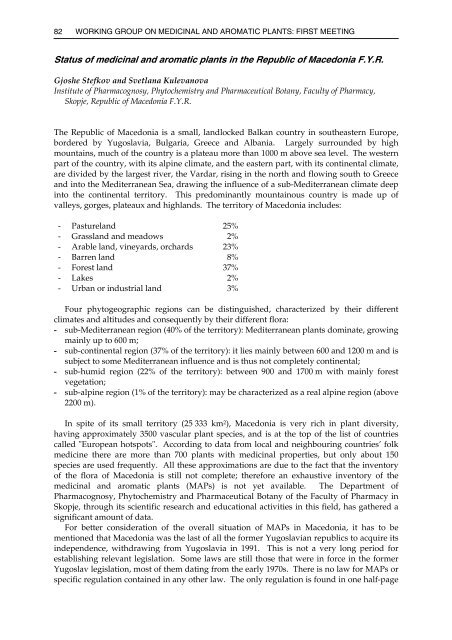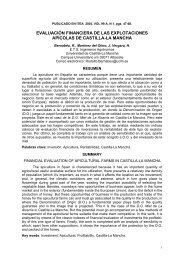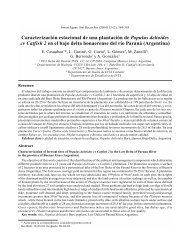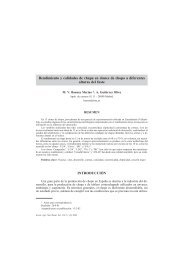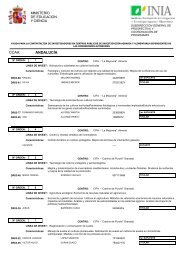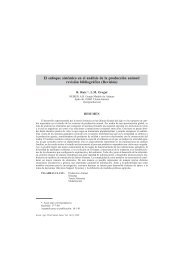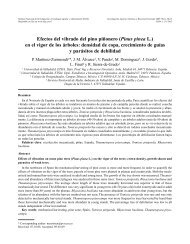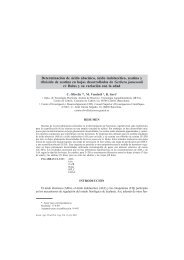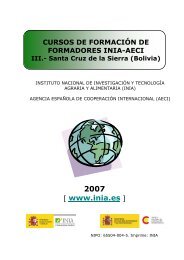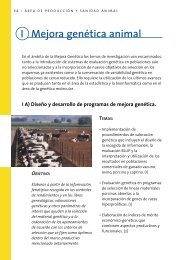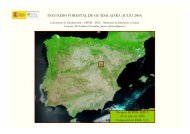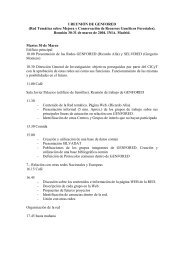Status of medicinal and aromatic plants in - Inia
Status of medicinal and aromatic plants in - Inia
Status of medicinal and aromatic plants in - Inia
Create successful ePaper yourself
Turn your PDF publications into a flip-book with our unique Google optimized e-Paper software.
82<br />
WORKING GROUP ON MEDICINAL AND AROMATIC PLANTS: FIRST MEETING<br />
<strong>Status</strong> <strong>of</strong> <strong>medic<strong>in</strong>al</strong> <strong>and</strong> <strong>aromatic</strong> <strong>plants</strong> <strong>in</strong> the Republic <strong>of</strong> Macedonia F.Y.R.<br />
Gjoshe Stefkov <strong>and</strong> Svetlana Kulevanova<br />
Institute <strong>of</strong> Pharmacognosy, Phytochemistry <strong>and</strong> Pharmaceutical Botany, Faculty <strong>of</strong> Pharmacy,<br />
Skopje, Republic <strong>of</strong> Macedonia F.Y.R.<br />
The Republic <strong>of</strong> Macedonia is a small, l<strong>and</strong>locked Balkan country <strong>in</strong> southeastern Europe,<br />
bordered by Yugoslavia, Bulgaria, Greece <strong>and</strong> Albania. Largely surrounded by high<br />
mounta<strong>in</strong>s, much <strong>of</strong> the country is a plateau more than 1000 m above sea level. The western<br />
part <strong>of</strong> the country, with its alp<strong>in</strong>e climate, <strong>and</strong> the eastern part, with its cont<strong>in</strong>ental climate,<br />
are divided by the largest river, the Vardar, ris<strong>in</strong>g <strong>in</strong> the north <strong>and</strong> flow<strong>in</strong>g south to Greece<br />
<strong>and</strong> <strong>in</strong>to the Mediterranean Sea, draw<strong>in</strong>g the <strong>in</strong>fluence <strong>of</strong> a sub-Mediterranean climate deep<br />
<strong>in</strong>to the cont<strong>in</strong>ental territory. This predom<strong>in</strong>antly mounta<strong>in</strong>ous country is made up <strong>of</strong><br />
valleys, gorges, plateaux <strong>and</strong> highl<strong>and</strong>s. The territory <strong>of</strong> Macedonia <strong>in</strong>cludes:<br />
- Pasturel<strong>and</strong> 25%<br />
- Grassl<strong>and</strong> <strong>and</strong> meadows 2%<br />
- Arable l<strong>and</strong>, v<strong>in</strong>eyards, orchards 23%<br />
- Barren l<strong>and</strong> 8%<br />
- Forest l<strong>and</strong> 37%<br />
- Lakes 2%<br />
- Urban or <strong>in</strong>dustrial l<strong>and</strong> 3%<br />
Four phytogeographic regions can be dist<strong>in</strong>guished, characterized by their different<br />
climates <strong>and</strong> altitudes <strong>and</strong> consequently by their different flora:<br />
- sub-Mediterranean region (40% <strong>of</strong> the territory): Mediterranean <strong>plants</strong> dom<strong>in</strong>ate, grow<strong>in</strong>g<br />
ma<strong>in</strong>ly up to 600 m;<br />
- sub-cont<strong>in</strong>ental region (37% <strong>of</strong> the territory): it lies ma<strong>in</strong>ly between 600 <strong>and</strong> 1200 m <strong>and</strong> is<br />
subject to some Mediterranean <strong>in</strong>fluence <strong>and</strong> is thus not completely cont<strong>in</strong>ental;<br />
- sub-humid region (22% <strong>of</strong> the territory): between 900 <strong>and</strong> 1700 m with ma<strong>in</strong>ly forest<br />
vegetation;<br />
- sub-alp<strong>in</strong>e region (1% <strong>of</strong> the territory): may be characterized as a real alp<strong>in</strong>e region (above<br />
2200 m).<br />
In spite <strong>of</strong> its small territory (25 333 km 2 ), Macedonia is very rich <strong>in</strong> plant diversity,<br />
hav<strong>in</strong>g approximately 3500 vascular plant species, <strong>and</strong> is at the top <strong>of</strong> the list <strong>of</strong> countries<br />
called "European hotspots". Accord<strong>in</strong>g to data from local <strong>and</strong> neighbour<strong>in</strong>g countries’ folk<br />
medic<strong>in</strong>e there are more than 700 <strong>plants</strong> with <strong>medic<strong>in</strong>al</strong> properties, but only about 150<br />
species are used frequently. All these approximations are due to the fact that the <strong>in</strong>ventory<br />
<strong>of</strong> the flora <strong>of</strong> Macedonia is still not complete; therefore an exhaustive <strong>in</strong>ventory <strong>of</strong> the<br />
<strong>medic<strong>in</strong>al</strong> <strong>and</strong> <strong>aromatic</strong> <strong>plants</strong> (MAPs) is not yet available. The Department <strong>of</strong><br />
Pharmacognosy, Phytochemistry <strong>and</strong> Pharmaceutical Botany <strong>of</strong> the Faculty <strong>of</strong> Pharmacy <strong>in</strong><br />
Skopje, through its scientific research <strong>and</strong> educational activities <strong>in</strong> this field, has gathered a<br />
significant amount <strong>of</strong> data.<br />
For better consideration <strong>of</strong> the overall situation <strong>of</strong> MAPs <strong>in</strong> Macedonia, it has to be<br />
mentioned that Macedonia was the last <strong>of</strong> all the former Yugoslavian republics to acquire its<br />
<strong>in</strong>dependence, withdraw<strong>in</strong>g from Yugoslavia <strong>in</strong> 1991. This is not a very long period for<br />
establish<strong>in</strong>g relevant legislation. Some laws are still those that were <strong>in</strong> force <strong>in</strong> the former<br />
Yugoslav legislation, most <strong>of</strong> them dat<strong>in</strong>g from the early 1970s. There is no law for MAPs or<br />
specific regulation conta<strong>in</strong>ed <strong>in</strong> any other law. The only regulation is found <strong>in</strong> one half-page


